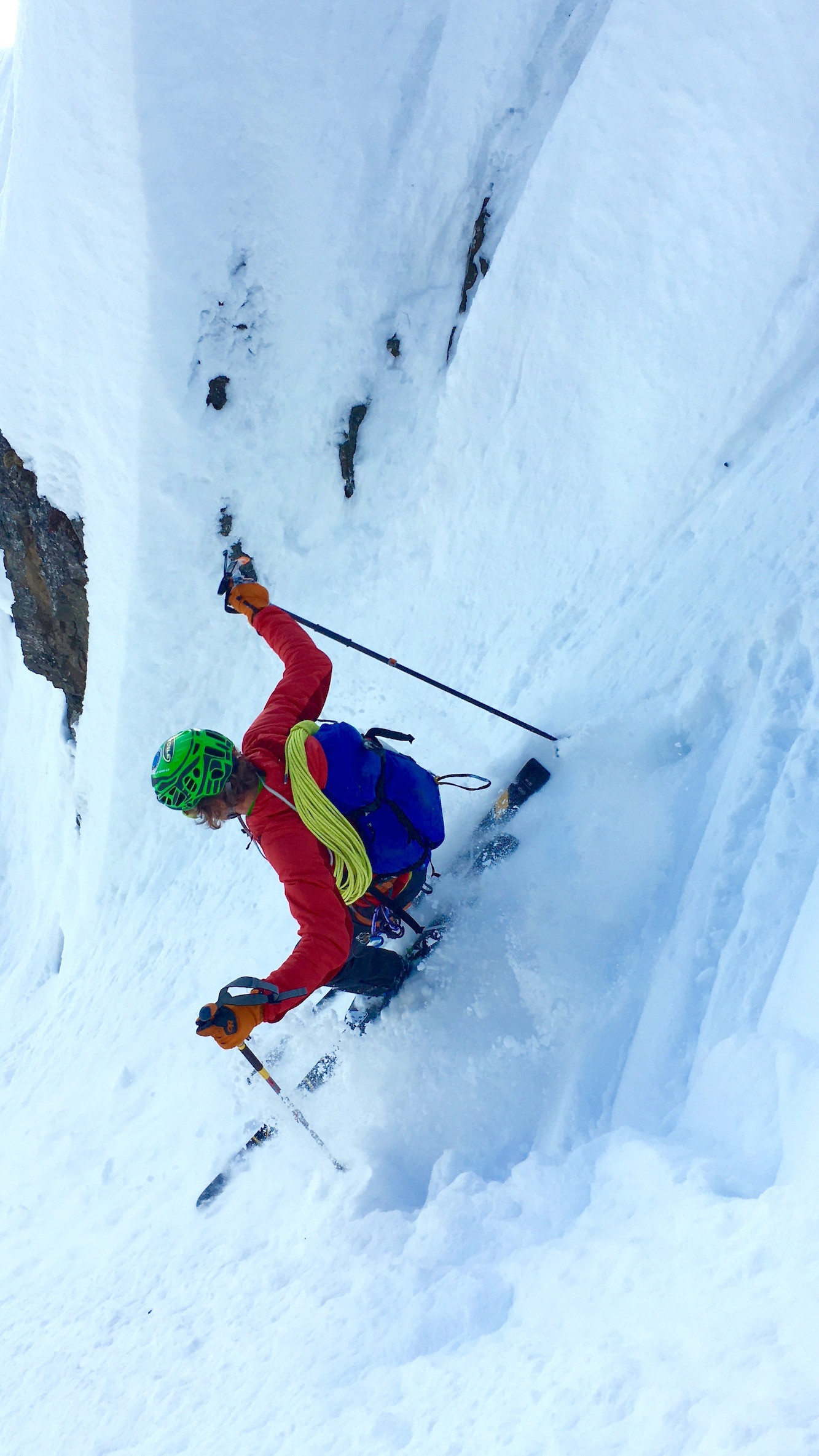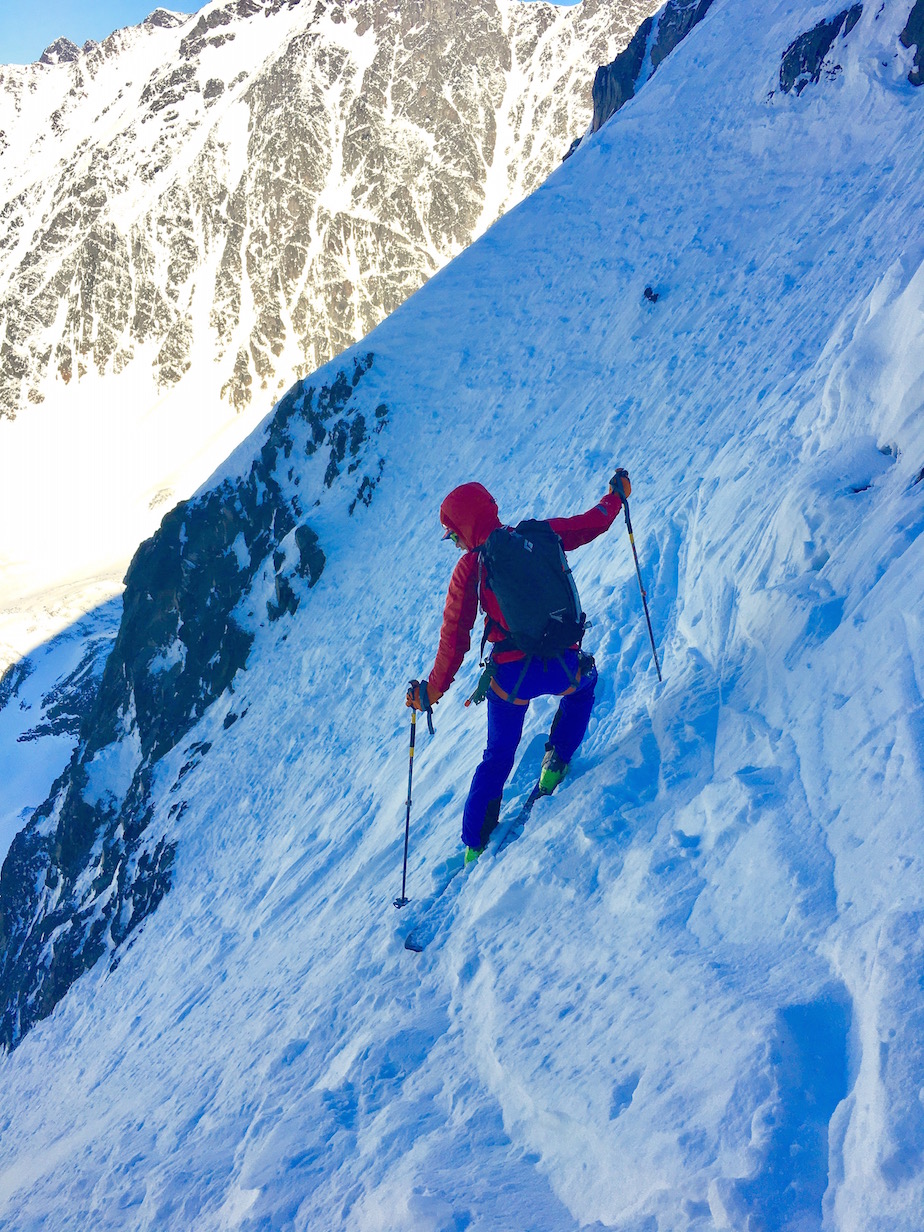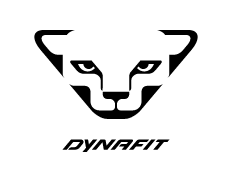 No time to be worrying about your bindingsI guess it's time to end the silence on these pages. Funny how the blog-scape has changed with the times. It seems that peoples' attention spans have shortened and now folks gravitate toward short hits of adventure and related gear stories. I'm guilty of gravitating to Instagram myself. But ideas continue to percolate in my brain and I'm finally feeling motivated enough to share some thoughts. Hell, it costs me $15/month just to have this site active so I might as well contribute. Hopefully, someone is still reading.
No time to be worrying about your bindingsI guess it's time to end the silence on these pages. Funny how the blog-scape has changed with the times. It seems that peoples' attention spans have shortened and now folks gravitate toward short hits of adventure and related gear stories. I'm guilty of gravitating to Instagram myself. But ideas continue to percolate in my brain and I'm finally feeling motivated enough to share some thoughts. Hell, it costs me $15/month just to have this site active so I might as well contribute. Hopefully, someone is still reading.
Any readers that have followed me on Instagram (https://www.instagram.com/brian.skimolife/?hl=en) have noticed my favoritism toward steep skiing. While a good portion of the backcountry skiing community seeks out fresh, untracked powder as their preferred distraction, my partners and I deviate from the herd, looking for more obscure, hard to get to, sometimes unskied lines that might scare us more often than not. This is a problem, I'll admit. But our motto is, "...position over conditions every time!". It's true. Given a choice between a lovely field of 25 degree stable blower pow or a choked-off, rocky, styrofoam-floored couloir high on some creepy, cold North face...well, you know where you'll find us.
 Mat Brunton contemplating the next turnThere's not a lot of ripping huge turns going on in our world a good deal of the time. It's one-turn-at-a-time, often jumping into the air between each, poking the surface, holding our breaths wondering if the whole thing might rip. Each airborn change of direction and brief loss of contact with the surface creates an instant opportunity for disaster. With each successful landing comes the addicting rush of another disaster averted. But honestly, we sniff around a lot, sometimes on belay, so we have a good idea that conditions will permit a descent. Caution nearly always prevails since any sort of misstep in these places would lead to some sort of epic or worse.
Mat Brunton contemplating the next turnThere's not a lot of ripping huge turns going on in our world a good deal of the time. It's one-turn-at-a-time, often jumping into the air between each, poking the surface, holding our breaths wondering if the whole thing might rip. Each airborn change of direction and brief loss of contact with the surface creates an instant opportunity for disaster. With each successful landing comes the addicting rush of another disaster averted. But honestly, we sniff around a lot, sometimes on belay, so we have a good idea that conditions will permit a descent. Caution nearly always prevails since any sort of misstep in these places would lead to some sort of epic or worse.
Playing this game requires a combination of physical, mental and material preparation. Truth be told, steep skiing is performed everyday with a variety of ski mountaineering gear. Big boots, race boots, light skis, heavy skis, platform bindings, race bindings all do the trick. But for me and my ilk, lighter gear nearly always prevails. Why ski one great line when you can ski two or three in a single outing? That kind of volume obsession generally requires gear that will allow us to travel farther with less energy. Heavy shit simply won't cover it.
Gear failure is not an option, either. Of course, I realize equipment breaks all the time. Not just light stuff but ALL gear. We play the odds, for sure. But we try to play the odds with equipment that has a strong pedigree and durability testing that reduces the risk. Race bindings, for instance, get severely hammered in skimo race competitions and the stress of one-turn-at-a-time ski alpinism pales in comparison. The simplicity of these bindings systems actually makes them more reliable and less prone to failure. For instance, there are far more failures of widely adjustable, multi-featured heel pieces than the simpler race heel designs found on all my skis.
As skimo racing has grown, so, too, have the race binding choices. Shops like Skimo Co in Salt Lake City have made huge strides in bringing this gear to North America. When I first started, the only way to get your hands on the trickest offerings from Europe was to shop there. Oh, how times have changed. The increase in choices has allowed me, for better or worse, to diversify my binding quiver... just because. I'll admit it. I'm a gear geek. I'm a guy with enough disposable income to do this silliness while secretly hoping to find the key to making me a better skier (I'm still looking...).
My ski quiver now sports four different brands of bindings and an additional generation or two of at least one brand. I committed early to race bindings for all my skiing and have no plans on changing that. Honestly, I fail to see any reason why most skiers don't lean in the same direction given the reduction in weight that these systems offer. And while some would argue that these bindings are somehow less "safe" than more complicated models, testing of many of the race models suggests otherwise. The bottom line is you can blow your knee on any kind of binding and people do everyday. Your best bet is to ski smart, under control and come into the season with some strong-ass legs. But I digress...
So, what I'll do here is talk about the bindings I have and use and what I think of them. Remember, this is a blog and these are my OPINIONS. Nothing more. You may find someone blathering on like this with a different opinion. Take both with a grain of salt and use these points of view to help you with your own decisions. But, ultimately, it's your decision to make. Commit and accept your fate.
Characteristics
What am I looking for in a binding? First, I want something that will do the job, ie. hold my boots firmly to my skis. The connection has to be solid and reliable. Some tech bindings do this more obviously than others. Over the years, I've seen seemingly identical mechanisms behave very differently when I finally step into the binding. This likely has to do with the springs involved and the subtle differnences in the engineering and design. Some toe piece designs tolerate ice better than others, for instance. The width of the boot toes and the varying spacing of the tech inserts in them from brand to brand also impacts this characteristic. What looks the same may be different in subtle ways. Often, the only way to discover these nuances is to ski them. I've done some of the leg work for you.
Next, I want something that's light. I've covered this above but weight matters. Lately, I've given up a few grams in order to capitalize on some of these other points. Pick your poison.
Third, durability matters. If a toe piece wing snaps in the middle of a hop turn on a firm, 50 degree slope you could die. Period. Or, your binding could break in a less critical position but you're left 10 miles in with only one ski. Problematic, to say the least. So, I want gear that will fail as infrequently as possible. My choices these days center around either known issues or my own biased perceptions of potential issues.
Last is the issue of release. This is a hot topic for many and I get it. A blown knee is a huge bummer. As an orthopedic physician assistant, I've seen this hundreds of times and have followed patients through rehab more times than I can count. Some skiers may think that heavily featured bindings are safer but I'm not convinced that's true. Release testing of a multitude of race bindings by the folks at Skimo Co using the Montana Jetbond device have revealed that the simple race bindings release in predictable fashion and often have lower DIN values than the featured choices. Bottom line here is that skiing is dangerous but you don't necessarily give up safety when you give up weight. Likely the most important thing to do to increase your safety is to unlock your toes when descending. But that's a whole other discussion.
My Brands
Although Dynafit dominated the tech binding market as the original innovator for around a decade and half, expiration of the patent in the mid 2000's led to several European machine shops jumping into the tech binding market. This increased competition led to innovation. Plum, originally a maker of cams and motorcycle machine parts, decided to get into the binding business in 2007 as the owner's son was a skimo racer. Located just west of Chamonix in the Haute-Savoie region of France, the company enjoyed an enthusiastic following of both Euro and North American skiers. They expanded their line but maintained their position as makers of light and reliable bindings. Truth be told, some of their more relaxed touring models had some durability issues but they failed to appear in the race line up. I adopted them early on with only one issue where my lost ski slammed into the side of a rock wall and sheared off a toe wing. Other than that, I trust my life to them.
Intitially, the Race toes (86 grams) went into "lock" mode when you stepped in but alterations of the rules for skimo racing has led to a requirement for a "release" mode in all bindings. Plum Race 145 in original "auto lock" modePlum has followed suit, something undoubtedly attractive to many non-racing ski mountaineers.
Manually releasing the toe when exiting the binding requires some significant force, more than Dynafit but not as much as Kreuzspitze.
Plum was one of the first to offer a heel piece with an adjustment plate (Race 170) so that boot sole length differences could be accounted for on the same pair of skis up to 10mm. This is a nice feature shared by other brands. The way each binding fixes this length varies. Some use an adjustment screw (Trab Gara) while others use either 2 or 4 screws holding down the heel piece. Plum uses two. I prefer four. Some Thread Lock can eliminate some of the issue with the screws loosening. The height of the heel piece on the 170 is lower than the standard race heel in order to keep the ramp minimal (delta=2.5mm).
Plum has refused to expand their production numbers, keeping quality high while continuing to tweek design and durability. They're still used by many steep skiers, particularly in the Chamonix region of the alps.
These guys are another small Italian machine shop making quality tech bindings. I'm a big fan of their 4 screw adjustable heel plate. I like it better than the Plum Race 170 which features only two screws. Of late, I've been a little frustrated by the performance of the toe piece in my current choice of boot, the Arcterx Procline, noticing a hestitancy of the pins to snap in place with step in. This has vexed me to the point that I have drilled an extra set of inserts in my skis so that I can use Dynafit Speed toes instead (see below). Luckily, two of the holes are shared between models.
The Kreuzspitze SCTT toe (78 grams) features a beautifully machined crampon receptical that is without peer. The aftermarket adjustment plates allow for 14-40mm of adjustment between three different size plates. These plates put the ramp delta at 5mm. Like Plum, this toe requires some force to release manually when exiting and the lever lacks a nice receptor for the ski pole tip found on the Dynafit.
Just to try something different this year, I bought a pair of Trab Gara Titan Adjustable (78 grams with plate) bindings for use on a new pair of Movement skis. The spring mechanism of the toes is unique in that the lever in front is actually part of the spring retention mechanism of the pins. As such, the lever must be held down while putting your toe in with pin holes properly aligned. This creates a slightly different kind of fiddle that's easily mastered. The absence of springs under the wings eliminates a common point of icing that can create retention issues in other brands. Nice touch. On the other hand, the tour mode/full lock out of the toes requires a firm snap of the somewhat flexible plastic lever. I don't know if they break but it feels a little sketchy to me each time I yank on it. Additionally, the lever is impossibly difficult to "unsnap" and I've taken to using my ski pole to knock it unlocked. This is awkward when transition space is tight. As a result, it's unlikely I'll use these bindings on outings where such situations are likely to be encountered.
The ramp is several millimeters higher on the Trabs (delta=7mm) due to the taller heel piece. Not a deal breaker but noticeable compared to the other two above. The single adjustment screw of the heel allows for 28mm of fore/aft freedom. The ski crampon receptor is a little tight and requires some tweeking initially, at least with my B & D Ski Gear crampons.
Finally, the company that started the tech binding revolution. I started out with several models of Dynafit bindings years ago but drifted away from the brand when I was racing and other brands came on line that were simply better in ways I was seeking. Dynafit rose to the challenge of a competitive market with equal amounts of success and failure. But one product which I consider a raging success is the Speed Radical toe piece (145 grams). Its time-tested design has seen few failures and subtle improvements like the toe stops (photo) which aid in stepping in are true innovations. I'm willing to give up about 50 grams per toe piece compared to the others. The sturdy nature and ease of operation are worth it. The crampon receptor is elegant. The front toe lever is positive while not being overly stiff to operate.
Hybrid is the Answer
My favorite binding is actually a hybrid of the Dynafit Speed toe and either the Kreuzspitze or Plum adjustable heels. This gives me confidence boosting toe fixation with ease of entry and the simplicity and adjustability of a race heel. It's true that these race heels lack a high rise position for steep skin tracks but, really, it just motivates me and my ilk to put in sensibly pitched skinners for all to enjoy. Arm waxing is for idiots and 20-somethings!



